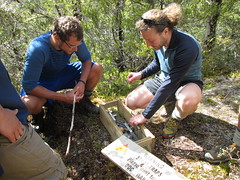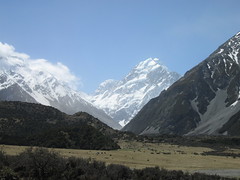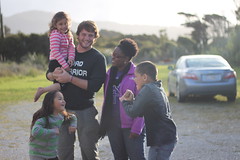Stoat Trapping With Andrew Shepard
 Our journey through the South Island high country has yielded some truly amazing scenery. The snowcapped mountains and tussock covered valleys of the Southern Alps offer the iconic landscapes of New Zealand. The small town of Makarora is no exception to this rule and was the setting for my two-day service placement (November 5&6). A group of four students and I signed up for the “stoat trapping” option and stayed with Andrew and Ingrid Shepard, who were very gracious hosts.
Our journey through the South Island high country has yielded some truly amazing scenery. The snowcapped mountains and tussock covered valleys of the Southern Alps offer the iconic landscapes of New Zealand. The small town of Makarora is no exception to this rule and was the setting for my two-day service placement (November 5&6). A group of four students and I signed up for the “stoat trapping” option and stayed with Andrew and Ingrid Shepard, who were very gracious hosts.
I spent the majority of my days tramping and checking stoat traps with Andrew and my fellow students. To give a little context, stoats are an invasive species similar in stature to a ferret. They were actually introduced to New Zealand in an effort to curb the exploding rabbit population, which ended up going horribly wrong. It was discovered that they are devastating to the native bird population and are now the target of various conservation groups like “Forest and Bird” and the “New Zealand Department of Conservation,” commonly referred to as “DOC.”
Andrew is a seasonal worker for DOC and voluntarily manages several of the stoat trapping lines in and around Makarora. He led our band of five eager students on a few of these trap lines, which were incidentally beautiful hikes as well! We would remove any dead pests and reset the traps as necessary. A secondary objective was to call in and spot any native yellow head birds (Mohua in Maori) in the areas that we checked traps. We had success in both areas as we came across several dead stoats and spotted live yellow heads singing in the trees on multiple occasions. Andrew was hopeful in the effectiveness of these lines since we found far less trapped stoats and heard more yellow heads compared to his check 6 weeks prior.
A common theme in our discussions of New Zealand conservation is that it is necessary to kill certain animals to protect the life of another. Animals labeled as “pests” are slaughtered in huge numbers while “native” or “endemic” species are fiercely protected. Our group discussions have brought up differing opinions and some heated debates on the subject. Some would argue that it is our ethical responsibility to clean up a man-made mess such as an introduced species that is damaging biodiversity. Others feel that animals like stoats deserve to live, or would cost far too much time and money to bring about even a small decrease in their numbers.
The time that I spent with Andrew doing this kind of field work has really cemented my feelings on the issue. While checking the stoat traps, I could actually connect with a species that is directly benefiting from their implementation. The yellow head bird that I mentioned earlier is making a measurable comeback in the area due to the efforts of hopeful people like Andrew. Seeing the action come full circle combined with Andrew’s enthusiasm has made me a believer in this grisly practice. It may be a messy job, but someone has to do it to protect the unique biodiversity in such a unique and wonderful place like New Zealand.
– Jacob Kaufman
At the beginning of our trip, during our time on the North Island,  many kiwis told us how beautiful the South Island was and how much we should look forward to our time here. I couldn’t imagine anything more beautiful than the black sand beaches, luscious forests and amazing sunsets. Once we arrived on the South Island I was blown away by the scenery and the wide open spaces of the high country. I felt privileged to spend so much time in the part of the country that is so admired by the people of New Zealand.
many kiwis told us how beautiful the South Island was and how much we should look forward to our time here. I couldn’t imagine anything more beautiful than the black sand beaches, luscious forests and amazing sunsets. Once we arrived on the South Island I was blown away by the scenery and the wide open spaces of the high country. I felt privileged to spend so much time in the part of the country that is so admired by the people of New Zealand.
My work experience in the South Island involved working with Andrew Shepard. Our work group included approximately ten students, and we spent the two days weeding and planting trees. Although the weeding wasn’t especially entertaining, we eventually learned that we were caring for the trees previously planted by the last EMU Cross-cultural group. It was powerful for me to see the University’s lasting influence on the land of New Zealand. My experience planting trees the next day was very meaningful for the same reason. I feel like much more than a student just visiting and passing through, now I know I can leave something behind that will have a lasting impression on the earth. Maybe the trees I helped plant will outlive me.
During the remainder of our stay in the South Island the group has discussed a lot about our impact on the earth. I’ve realized that it is our responsibility as Christians to care for the earth, and doing this service project has certainly helped me come to that conclusion. New Zealand has given me such beauty and so many wonderful experiences; it’s been a privilege to give back in a positive way. I am cherishing these last few weeks I have before leaving the country.
-Rachel Kelley
What’s up EMU?!!!!!!
 Okay, so it’s my turn to update everyone back home on how New Zealand has been treating me. To put it simply, it’s been spectacular. I’m sure you’ve read bits and pieces from other journal entries that the communications team has put up. A few highlights for me have been sea kayaking, fishing, black water rafting, white water rafting, and jumping off of waterfalls. I could talk all day about the fun I had doing these things, but to avoid being repetitive, I will refrain. Instead, I will write about my recent farm stay. Gregory Knight and myself were privileged enough to spend 3 nights and 2 days at the home of Willy and Kaye Aspinall on the Makarora River Ranch.
Okay, so it’s my turn to update everyone back home on how New Zealand has been treating me. To put it simply, it’s been spectacular. I’m sure you’ve read bits and pieces from other journal entries that the communications team has put up. A few highlights for me have been sea kayaking, fishing, black water rafting, white water rafting, and jumping off of waterfalls. I could talk all day about the fun I had doing these things, but to avoid being repetitive, I will refrain. Instead, I will write about my recent farm stay. Gregory Knight and myself were privileged enough to spend 3 nights and 2 days at the home of Willy and Kaye Aspinall on the Makarora River Ranch.
The Makarora River Ranch is a ranching station on the South Island that covers more than 8,000 acres of paddocked pasture land as well as the steep slopes of the nearby mountain range. The owner is Mr. Bobby Hill, a successful businessman and fellow American. He had a very specific vision for this property when he purchased it for just a few million dollars. This vision was to use the paddocks to raise a few sheep and cows, to utilize all the land, but mainly focus on turning the steep slopes of the mountain into a hunting park. He bought up Red Deer and Tahr (a rare goat from the Himalayan Mountains) and has been breeding and raising trophy animals ever since. Mr. Hill doesn’t actually have much to do with the property besides his vision. He actually resides in Texas and has no experience in running a ranch, so he hired Willy and Kaye to manage the ranch. They have one employee, Coop, and the three of them run the place. Mr. Hill also hasn’t done a lot of marketing or advertising of the hunts on the ranch. At 12,000 dollars for one trophy shoot and 1,500 dollars for a bull Tahr, the only legitimate business they get for hunts is wealthy hunters. So Willy has had the difficult task of diversifying the ranch enough to still keep it afloat. This has included collecting velvet from the stag antlers to sell to the Koreas, China, and Japan, and selling venison (a Christmas delicacy) to Germany, as well as expanding the sheep and cattle herds. The ranch was home to some 2,000 Perendale sheep, 650 Angus-Hereford beef cattle, several hundred Red Deer, and a few hundred Tahr roaming around the mountain tops in the top paddocks.
Greg and I went into our farm stay expecting to be worked hard and fed well. We were not disappointed. We spent the majority of the first day splitting and loading wood to heat the different buildings around the farm. We had four meals a day and it seemed like we were always stopping to eat, but we didn’t complain because we were always hungry. The second day we did a lot of little jobs; anything from loading wood, to unloading these giant heavy fence posts,(which 58 year old Willy did with ease and Greg and I struggled to keep up) to bottle feeding orphan lambs and a calf. But the afternoon was the highlight of my time working on the ranch for sure.
As we finished with lunch, Willy was trying to think of a good job for us to do while still getting the experience of the ranch. He settled on sheering sheep. This, as I had learned already from several Kiwis on my travels, was a must during my time in New Zealand. So I was excited to get a shot at it. We ran two wild ones who had not been sheered with the main herd. Willy did the first one, just zip, zip, zip and it was done. The fleece was all in one piece ready to go. Then it was our turn. Greg insisted that I go first, so I sat it down, held its feet above its head, held the head between my legs, and started sheering. I quickly realized that it wasn’t quite as easy as Willy made it look. After about ten minutes bent over this stupid ewe I tapped out and let Greg have a try. I had made a mess of it and cut the sheep all up everywhere. I had done the easy chest part and left Greg with the hard parts. Wool was everywhere and it was hard to see where to run the razor, so Greg, who forgot we were trying to keep the coat in one piece, started sheering pieces off and throwing them to the side. I caught a quick glance of horror in Willy’s eye, and when he saw me looking at him he just smiled. After 10 minutes or so, Greg was exhausted so Willy went for a minute of two, cleaned it up a bit, and let me finish up. Soon, there was another bald little sheep, although I don’t know how happy she was with her hair cut. It was shoddy at best and she had about half a dozen holes up the legs and back. Willy said it wasn’t as bad as it looked and that we did just fine for our first time.
That night, while I was waiting for my shower, I sat out on the front step looking out as the sunset behind the snow-capped mountain at the skyline. I had cow crap on my boots, several great big popped blisters on my left hand, a large gash on my right hand, deer hair on my gloves, lamb blood all over my pants, and the truth is I was more happy at that moment than I’ve been all trip, which is really saying something.
Well, that is all I got. Y’all will just have to track me down when I get back and ask how the rest was. I have a great story about diving nude through underwater caves from free travel which is hilarious. But until then, don’t miss us too much. There is just a month or so until we will be in for a chapel.
Stay classy EMU,
-Jacob David Wheeler